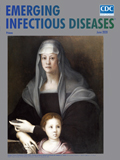
Volume 26, Number 6—June 2020
Dispatch
Prevalence of Escherichia albertii in Raccoons (Procyon lotor), Japan
On This Page
Figures
Article Metrics
Abstract
Natural reservoirs of Escherichia albertii remain unclear. In this study, we detected E. albertii by PCR in 248 (57.7%) of 430 raccoons from Osaka, Japan, and isolated 143 E. albertii strains from the 62 PCR-positive samples. These data indicate that raccoons could be a natural reservoir of E. albertii in Japan.
Escherichia albertii is a gram-negative facultative anaerobic bacterium and an emerging human enteropathogen. This bacterium belongs to the group of attaching and effacing pathogens, which can form pedestal-structured lesions on intestinal epithelium by using an eae-encoded adhesin called intimin and a type 3 secretion system. E. albertii commonly carries cytolethal distending toxin genes; in addition, certain strains carry Shiga toxin 2 (stx2a, stx2f) genes (1), suggesting that E. albertii has a potential to cause severe diseases such as hemorrhagic colitis and hemolytic uremic syndrome in humans, similar to Shiga toxin–producing E. coli. An increase in human outbreaks and sporadic cases of E. albertii have been reported recently from several countries, including Japan (1–3). However, the reservoir and transmission routes of E. albertii to humans have not yet been identified. We surveyed wild raccoons (Procyon lotor) captured in Osaka, Japan, for the presence of E. albertii to determine if raccoons could be a reservoir of E. albertii in Japan.






















.png)











No hay comentarios:
Publicar un comentario